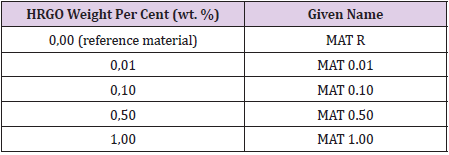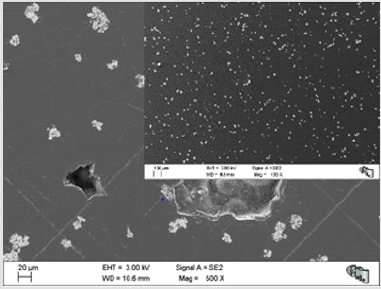Abstract
Bone cement is wildly used in different arthroplasty surgical procedures, such as those regarding arthrosis and other prevalent illnesses. Its manufacture reaches high temperatures that can produce cell damage in the patients’ surrounding tissue. We have studied how different percentages of HRGO can modify its mechanical, physical, and microstructural properties and processing. We concluded that a lower sintering temperature would be reached with this addition, making it more suitable for human use simultaneously as it reduces its adverse effects and contraindications. In contrast, the materials’ density does not show significant changes, which indicates that the addition of HRGO does not increase porosity significantly. Lastly, the mechanical properties are reduced by almost 20%. Nevertheless, these properties are high enough so that the new materials can still fulfil their structural function.
Keywords:PMMA Bone Cement; Graphene; Mechanical; Physical; Processing; Microstructural Behaviour; Orthopaedic and Trauma Surgery
Abbreviations: PMMA: Polymethylmethacrylate; HRGO: Highly Reduced Graphene Oxide Layers; DSC: Differential Scanning Calorimetry; FESEM: Field Emission Scanning Electron Microscopy
Introduction
Bone cement is of paramount importance in Orthopaedic and
trauma surgery due to its crucial role in the success of total joint
replacement and newer treatments such as percutaneous vertebroplasty
and kyphoplasty. Thus, it is widely used for implant fixations,
acting as a space-filler that creates a tight space between different
parts of the prosthesis and/or the prosthesis and the patient’s organic
material. It allows the absorption of small deformations as it
has a modulus of elasticity and mechanical properties like those of
the bone and one or two more orders of magnitude than the materials’
prosthesis. In this way, in case of reaching high stresses, the
bone will not break, much less the prosthesis, but the bone cement,
which is easily replaceable. Even though the uses and availability
of various bone cement’s types have been explored, some adverse
effects are associated with its use [1-3].
As bone cement is obtained from the mixture of two
precursors that produce a strongly exothermic reaction, one of
its main detriments is that it reaches over 60°C during the in-situ
polymerization process. Temperatures over 46°C are associated
with irreversible cellular death, thus producing significant damage
to the surrounding tissues. The heat released during the cement’s
polymerization has also been related to intestinal obstruction due
to adhesions and stricture of the ileum, as well as aseptic loosening
of the prosthesis. Moreover, the curing time cannot be controlled
during surgeries. It can either unnecessarily prolong them, causing
subsequent thromboembolic events, or shorten them, preventing
the surgeon from having enough time to complete the moulding,
either before or during the surgery. Hence, in this paper, we have
worked to optimise the structural properties of bone cement by
the addition of HRGO, a biocompatible material, producing four different options, each one with a different weight percentage of
graphene that covers three orders of magnitude [2,4-7].
Our goal is to determine the graphene’s influence in the
microstructural, mechanical, physical, and sintering behaviour
to obtain improved materials that avoid the previously described
problems and provide the optimal one for each anatomical
structure. As reference material, MAT R, marketed PMMA bone
cement CMW-1 Radiopaque of DePuy Ibérica was used. Our research
was combined with different proportions (wt. %) of HRGO. Both
are biocompatible and suitable for direct human use. The analysed
materials have been classified according to the different amounts
of HRGO in the material (Table 1). The materials’ processing has
been carried out under controlled conditions through a device
specifically built for this purpose. Nevertheless, for the sake of
reproducibility and application of pressures like those used by a
surgeon during his work, the method described by Frutos et al. was
followed [6,8-10].
For the temperature characterization during curing, four
equidistance high-resolution K-thermocouples were employed to
determine its evolution. A Mettler Toledo AG 245 balance, with
10-5 g resolution, has been used to ascertain the proportions of
PMMA and HRGO for the processing materials and the absolute
density, measured by pure ethanol immersion Archimedes method.
Mechanical behaviour has been determined with an Instron 5866
electromechanical testing machine. The strength has been assessed
from tensile tests, and the three-point bending (TPB) tests were
employed to quantify de fracture toughness (Frutos et al.). Finally,
the microstructural characterization has been done to ensure the
quality of the material and the presence of defects, by observing it
by FESEM (ZEISS Auriga), according to Palacios [6] et al.
Regarding the results shown in Figure 1, temperature
increment T during curing is reduced drastically with the HRGO wt.
% addition. Even with minimal additions, 0.01 %, reductions of T
are relevant (0,7°C).
Consequently, the damage will be reduced in adjacent tissues
when the proportion of HRGO increases. The relevance of this
accomplishment lies in its impact on the reduction of local
necrosis. Moreover, the temperature in contact with the bone can
be much higher since bones’ thermal conductivity is three to five
orders of magnitude smaller than our processing device’s steel.
As was foreseeable, the density (Table 2) decreases smoothly with additions of HRGO due to its lower density compared with PMMA.
This fact can also be related to an increase in the size and number
of pores in the sintered material associated with HRGO platelets’
addition, which can play a role as pore nucleators.
Microstructural characterization showed that the material with
the most notorious pore distribution is material MAT 1.00 (Figure
1), although it is not very different from that of the MAT R, with
0,00 % HRGO, that exhibited the minor distribution. Finally, the
materials’ mechanical analysis showed an apparent decrease, up to
20 %, of tensile strength and fracture toughness as the percentage
by weight of HRGO increased. This effect is related to the increment
of the size and number of pores introduced by the HRGO addition.
Nevertheless, this cutback is not of concern from a structural
point of view, as bone cement with graphene maintains a residual
capacity that meets its service requirements.
Figure 1: Microstructure of MAT 1.00. The pores (black/ grey holes) holes are several times larger than the radiopacifier particles (white dots).
Table 2: Mean value and mean quadratic error for temperature increment during curing, density, tensile strength, and fracture toughness as a function of wt. % of HRGO platelets.
Conclusion
From the analysis of the results, it is concluded that graphene’s addition substantially lowers the material’s curing temperature, avoiding or reducing the potential tissue damage during surgery. The addition of small percentages of graphene (HRGO) reduces the material’s final density and enhances its porosity. Consequently, the mechanical properties of the new materials can be reduced by 20%. Nevertheless, this unwanted side effect is not of concern as the residual mechanical strength of HRGO materials remains sufficiently high to fulfil their structural role.
Conflict of Interest
The authors declare no conflict of interest.
Acknowledgements
This work has been supported by the Spanish Government (PID2019-106631GB-C44, MICINN/FEDER, UE) and Comunidad de Madrid Government (P2018/NMT-4511 NMAT2D-CM, P2018/NMT-4411 ADITIMAT-CM, FEDER-UE). J. Orellana thanks scholarship provided by UPM and Ministerio de Educación, Cultura y Deporte of Spain (FPU17/02035). Y.Y. Pastor thanks Prof. J. Marco (UCM) for his continuous encouragement.
References
- Bandelette GC, Zoarski G, Manca A, Masala S, Eminefendic H, et al. (2008) Percutaneous vertebroplasty and bone cement leakage: clinical experience with a new high-viscosity bone cement and delivery system for vertebral augmentation in benign and malignant compression fractures. Cardiovascular and interventional radiology 31(5): 937-947.
- Künh KD (2014) Impact of Temperature on Cell Death in a Cell-culture Model of Hepatocellular Carcinoma. Anticancer Research 32(3): 915-921.
- Kuhn KD, Springer G (2013) PMMA Cements.
- Vaishya R, Chauhan M, Vaish A (2013) Bone cement. Journal of clinical orthopedics and trauma 4(4): 157-163.
- Frutos G, Pastor JY, Martínez N, Virto MR, Torrado S (2010) Influence of lactose addition to gentamicin-loaded acrylic bone cement on the kinetics of release of the antibiotic and the cement properties. Acta biomaterialia 6(3): 804-811.
- Palacios T, Tarancón S, Abad C, Pastor JY (2021) Saliva Influence on the Mechanical Properties of Advanced CAD/CAM Composites for Indirect Dental Restorations. Polymers 13(5): 808.
- Bandelette GC, Zoarski G, Manca A, Masala S, Eminefendic H, et al. (2008) Percutaneous vertebroplasty and bone cement leakage: clinical experience with a new high-viscosity bone cement and delivery system for vertebral augmentation in benign and malignant compression fractures. Cardiovascular and interventional radiology 31(5): 937-947.
- Künh KD (2014) Impact of Temperature on Cell Death in a Cell-culture Model of Hepatocellular Carcinoma. Anticancer Research 32(3): 915-921.
- Kuhn KD, Springer G (2013) PMMA Cements.
- Vaishya R, Chauhan M, Vaish A (2013) Bone cement. Journal of clinical orthopedics and trauma 4(4): 157-163.
- Frutos G, Pastor JY, Martínez N, Virto MR, Torrado S (2010) Influence of lactose addition to gentamicin-loaded acrylic bone cement on the kinetics of release of the antibiotic and the cement properties. Acta biomaterialia 6(3): 804-811.
- Palacios T, Tarancón S, Abad C, Pastor JY (2021) Saliva Influence on the Mechanical Properties of Advanced CAD/CAM Composites for Indirect Dental Restorations. Polymers 13(5): 808.

 Review Article
Review Article


